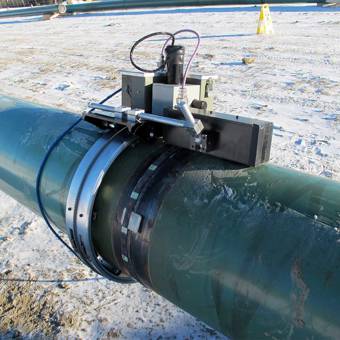Comprehensive Overview of Pipeline Welding Examination Procedures
Pipe welding examination treatments play a critical function in ensuring that welded connections meet stringent industry requirements and requirements. From precise pre-welding evaluations to comprehensive post-weld analyses, a distinct evaluation process is essential for keeping the structural stability of pipelines.
Pre-welding Examination Preparations
Before commencing the welding procedure, detailed pre-welding examination prep work are crucial to make certain the honesty and high quality of the weld joint. These preparations involve a meticulous examination of the products to be bonded, the welding devices, and the work environment. By performing detailed pre-welding assessment preparations, potential concerns can be recognized and fixed early on, leading to dependable and high-quality weld joints.
Welding Treatment Certification
Thorough pre-welding examination preparations lay the structure for the important process of Welding Treatment Certification, ensuring the honesty and quality of the weld joint. Welding Treatment Certification (WPQ) is a vital action in the welding procedure that includes screening and accrediting welding treatments to assure they satisfy specific requirements and requirements. The WPQ process typically includes welding procedure requirements growth, welding procedure qualification screening, and documents of the results.
During welding treatment spec growth, crucial details such as the welding procedure, welding products, joint design, and welding specifications are specified to create a detailed treatment. Ultimately, welding treatment credentials screening is performed to confirm the recommended treatment's integrity. This testing commonly includes welding examination discount coupons that go through different mechanical and non-destructive examinations to examine the weld's top quality and adherence to the defined requirements.
In-process Weld Assessment
During the welding procedure, in-process weld evaluation plays a critical role in ensuring the top quality and stability of the weld joint - Pipeline Welding Inspection. This sort of assessment includes keeping track of the welding criteria, evaluating the weld grain development, and discovering any type of possible flaws or interruptions as they take place. By performing in-process weld inspections, welding drivers can promptly deal with any type of problems that may occur, thus making sure and stopping more flaws that the last weld satisfies the called for specs
Typical techniques made use of for in-process weld inspection include visual evaluation, fluid penetrant screening, magnetic fragment screening, ultrasonic testing, and radiographic testing. On the whole, in-process weld inspection is important for maintaining the top quality and integrity of bonded pipes.
Non-destructive Screening (NDT)
Non-destructive Screening (NDT) is an essential technique employed in pipe welding inspection to examine the integrity of weld joints without causing damage to the bonded framework. By using various NDT techniques, assessors can assess the high quality of welds and recognize any flaws or gaps navigate to these guys that may jeopardize the structural sturdiness of the pipe. Common NDT approaches utilized in pipeline welding examination include Radiographic Testing (RT), Ultrasonic Screening (UT), Magnetic Particle Evaluating (MPT), Fluid Penetrant Testing (LPT), and Visual Screening (VT)
RT entails the usage of X-rays or gamma rays to create images of the inner structure of the weld, allowing examiners to identify problems such as porosity, cracks, or insufficient blend. Furthermore, VT involves aesthetic examination of welds to identify any click here for more info kind of noticeable blemishes.
Post-weld Evaluation and Documentation


Paperwork of post-weld assessment findings is necessary for preserving high quality control documents and making certain compliance with market standards and guidelines. Comprehensive reports must consist of information concerning the inspection approaches used, the area and nature of any type of problems found, and any type of rehabilitative actions taken - Pipeline Welding Inspection. Correct documents not just acts as a document of the weld's quality yet likewise aids in future upkeep and examination processes
Verdict

To conclude, pipeline welding evaluation procedures play a critical duty in making certain the high quality and honesty of welds. From pre-welding evaluations to post-weld paperwork, each step is vital in preserving the safety and security and efficiency of pipes. By complying with established procedures and performing comprehensive examinations, potential issues can be determined and addressed prior to they lead to expensive repair work or failings. Generally, adherence to correct examination procedures is key to the success of pipe welding projects.
From meticulous pre-welding inspections to detailed post-weld evaluations, a well-defined examination procedure is crucial for maintaining the architectural stability of pipelines. By carrying out in-process weld examinations, welding drivers can immediately attend to any type of issues that might arise, thereby making certain and preventing additional defects that the final weld fulfills the called for web specifications.
Usual approaches utilized for in-process weld inspection consist of visual examination, liquid penetrant screening, magnetic fragment screening, ultrasonic screening, and radiographic testing.Non-destructive Testing (NDT) is an important technique employed in pipe welding examination to analyze the honesty of weld joints without creating damage to the welded structure. Post-weld evaluation entails numerous approaches to assess the welds for problems, including aesthetic inspection, color penetrant testing, magnetic bit testing, ultrasonic screening, and radiographic testing.